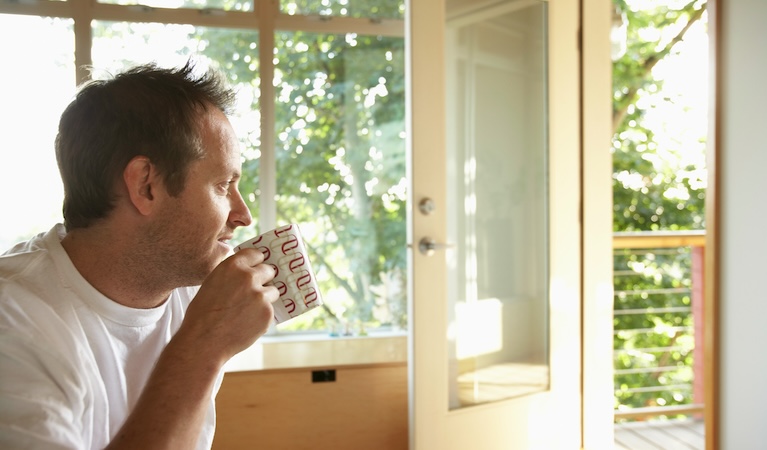Ah the good old British weather! Over the last few weeks we’ve experienced a complete mixture, including torrential rain, dramatic thunderstorms, very hot sun, and everything in between. The only certainty is that we can’t rely on the weather to be what we want or expect.
This also means that our homes need to be prepared for any kind of weather at any time. When it’s hot outside, we want them to keep us cool, and when it’s unseasonably cold outside, we need somewhere warm to retreat to.
Unfortunately, many of the ways that immediately come to mind to keep our homes cool or warm – such as fans, air conditioning, and central heating – also come with a hefty price tag in terms of the energy they use. It’s important to be aware of this, because even though energy prices have fallen twice this year, experts are predicting that they may rise again this autumn and winter.
So in this article we share a few tips about how to keep your home cool in the heat, and warm in the cold, without using more energy than you need.
Five ways to keep your home cool in the heat
Here are five tips that may help you to keep your home cool. The first three are things that you can do immediately. The fourth and fifth would take a little more time, effort, and perhaps some financial investment. But even if this involves a personal loan it could still be well worth it in the long term.
This is an easy one to start with. The golden rule to remember is that if the room you are in is warmer than the temperature outside then open the windows to let the cool air in. But if the temperature outside is hotter than inside your room, keep the windows closed.
Also wherever possible try to get a good flow of air going. For example, if you open both upstairs and downstairs windows, this can improve the circulation of air through the house as the hot air rises and cold air enters through the ground floor windows. Obviously just be mindful of any potential security issues when leaving windows open, particularly those downstairs.
Close blinds and curtains
The timing of when you close blinds and curtains is dependent on the type of materials they are made from. If you have thick dark curtains or blackout blinds it is often better to keep them open during the day, otherwise they could keep heat trapped in the room. But lighter curtains and blinds should be closed during the day, particularly when in full sunlight, because they can help to reflect the sun’s rays back out of the room.
Another useful way to bounce heat away from your windows is to put something reflective on the outside of the glass, similar to a car sunshield, which could reduce the temperature in the room by up to 25%.
Play it cool with sheets and pillows
Another simple fix to cool things down in your home at night is to make sure you are using the lightest weight bedding possible during the summer, and that it is changed regularly to keep it super fresh. Cotton is the best fabric for sheets and duvet covers as it breathes more easily and therefore stays cooler.
Another idea to keep bedding cool is to either slightly dampen your sheets or even put them in the freezer for a while before bedtime. Similarly, you could cool your pillow down either by placing an ice pack underneath it or creating your own “Chillow” by filling an inflatable camping pillow with iced water before bedtime.
Add solar control film to windows
A more far-reaching solution to keeping heat out of a room is to add solar control film to the windows. Solar control window film is available in a wide variety of finishes, from clear film that is almost impossible to notice, to tinted film or reflective film with mirrored effects.
The idea behind solar control window film is to provide a barrier that prevents solar heat and glare passing through whilst still allowing light to do so. It can be added either by yourself or with the help of a professional, and may be worth considering even just for windows of rooms that either receive the most sunlight or get the warmest.
Effective insulation in your home is so important both for keeping it cool in the heat, and warm in the cold. Think of it as a thermos flask for your home. Good wall, floor, loft and roof insulation can make a huge difference to your home.
It’s easy to understand how home insulation keeps your home warm, by preventing heat loss and also ensuring that your heating system doesn’t have to work as hard. But insulation also slows down the transfer of heat from outside to the inside of your home, so will keep your home cooler even if the exterior walls are hot to touch.
Insulation can be expensive but is often a good investment as it can dramatically cut energy costs in the long term.
Five ways to keep your home warm in the cold
Hopefully the really cold weather is still some time away, but it’s a good idea to prepare for those colder ways before the need becomes urgent. So here are three things that you can do in advance of any cold weather, and two ideas that can help you to keep your home warm when it arrives.
Make sure draughts can’t get in
No matter how good your central heating, if there are draughts in your home, it will still feel cold. So it is well worth checking thoroughly for draughts before the cold weather comes.
Start outside your home to see if you can spot anywhere that heat could escape from your home. At the same time, make sure that your boiler flue is completely clear of obstruction and that no pipes are damaged so that your heating is able to function safely and at its best level of performance.
Then check inside your home for any cracks in windows, doors or floorboards, that could allow heat to escape. Also check for unnecessary gaps around fireplaces, light fittings and appliance ventilation panels. Significant gaps and cracks can usually be filled with a silicone sealant. It’s also a good idea to use draught excluders for any problem areas such as under doors.
If there are persistent draughts and you can’t work out where they are coming from, try lighting a candle near places where they may possibly enter, and see if there is any change to the direction of the smoke from the candle. If you spot a draught you can then either find a way to seal it or add some kind of insulating material.
Start stocking up on logs and coal
If you have an open fire or wood burner it’s a good idea to gradually stock up on logs and coal well before the winter. Not only does this ensure you have a good supply, but it may well enable you to get good deals on items that are out of season. You may even find some local councils or parks are offering free wood giveaways if they have surplus after tree felling, and it’s also worth checking online sites such as Facebook Marketplace, Freebay and Gumtree.
If you are using an open fire or wood burner, just be sure that you are conforming to any local guidelines about this. Some areas are designated as smoke control areas, where you are limited as to how much smoke you can release from a chimney and the type of fuel that can be used. You can find out if your area is a smoke control area from Environmental Services at your local Council.
Prepare one main winter warm room
A great option to reduce your energy bills but still keep warm is to choose one room as your main warm room for winter. For example you may decide on your living room as the warm room, and plan to spend most of your waking hours in this room over winter.
This is the room that will be the warm heart of your home. Some ideas to make it really special are:
- Keep the heating on as much as needed during waking hours;
- Use draught excluders on all doors and windows;
- Have a plentiful supply of throws and blankets;
- Create a cosy ambience with candles and fairy lights.
Even if the rest of your home is a little on the chilly side, this is the room to enjoy life during the cold months.
There are many ways to reduce energy bills but still enjoy the benefits of central heating. One of these is to turn your thermostat down by just 1°C. This can save quite a bit of money on your heating bill and you most probably won’t notice the difference.
If you have a smart thermostat and related app, you can also be much more flexible about when heating goes on and off, and the temperatures that are set. And if you have individual thermostats on room radiators, you can ensure that these are turned up when the room is in use and down again at other times.
Also make full use of residual heat around the home. For example, day to day activities such as using the oven, shower, bath, washing machine, tumble dryer or dishwasher are all likely to generate some residual heat. If you leave internal doors open this will enable the resulting warm air to circulate round the rest of your home and help to keep it warm.
Embrace the power of layers
As well as relying on your central heating to keep you warm, also increase the number of layers you are wearing. This doesn’t have to feel heavy and uncomfortable : a few thin thermal layers can be all you need to keep you warm without feeling swamped.
However, if you prefer a heavier feel to keep you warm, check out the trend for wearable blankets. They come in a variety of shapes and styles, but essentially you will be wearing a blanket with sleeves and possibly a hood. Ideal for curling up on a chilly winter’s night, and you definitely won’t want the heating turned up too high when wearing one..
We hope that this article gives you a few helpful and cost effective ideas as to how to keep your home cool in the heat, and warm in the cold. But if you are ever in need of extra finances to help with sorting out a heating or cooling issue in your home, remember that Loans 2 Go offer emergency loans that may be able to help.
For more useful lifestyle and financial tips, visit us here again soon at Loans 2 Go.


 Receiving and posting gifts overseas this Christmas: All you need to know
Receiving and posting gifts overseas this Christmas: All you need to know 
















